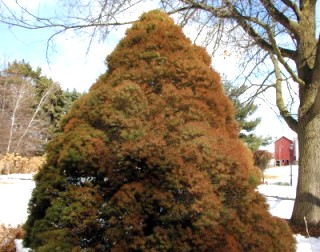Newly planted trees and shrubs, or those which were stressed during the previous growing season, are most likely to suffer winter damage. You can minimize damage by taking the precautions described below.
Perennials:
Cut back dead foliage and dispose of debris to prevent disease carryover. Mulch with a loose covering of hay or straw. This is very important for newly established plantings. Prune ornamental grasses in spring.
Deciduous shrubs
Protect valuable plantings from rabbits, mice, and deer
- Place a cylinder of hardware cloth around the branches.
- Spray with appropriate repellents.
- Put bait and traps our before the ground freezes.
Evergreens
Water all evergreens weekly until the ground freezes. Spray foliage of broadleaf evergreens with Wilt Pruf or Cloud Cover to prevent winterburn. Or place a burlap screen around the plant. Tie up branches of pyramidal evergreens with old panty hose or strips of cloth to prevent breakage from heavy snow and ice.

Deciduous Trees
Protect trunks from sunscald by applying tree wrap or vinyl tree guards. Protect trunks from critter damage by wrapping with vinyl tree guards or hardware cloth cylinders. Rake up and dispose of diseased leaves to prevent re-infection in spring.
Tender roses
Place rose collars around the base of the plant and fill with soil. Mound dirt over the graft union after the ground has frozen. Protect canes by cutting them back only as much as needed to fit under rose cones.
Misc.
Clean and sanitize bird baths and bird feeders. Set up bird feeding stations to include a source of drinking water. Invest in water heating units specifically designed for this purpose.
Prepare beds for spring planting by incorporating compost and leaves into the soil.
Sit back in your easy chair to dream of future projects.
